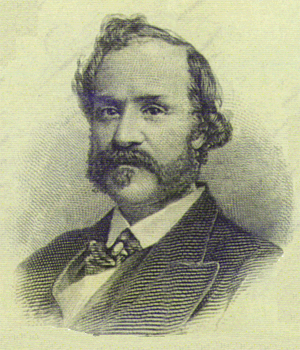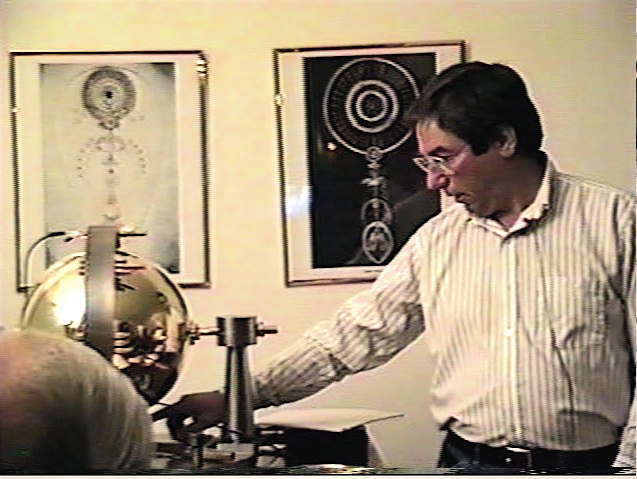| Check out the SVPwiki | SVP Cosmology 2.3 |
What Does Music Have to do with Physics?
by Dale Pond, 10/96, updated 1/97
Everything! Music is a comprehensive system of organized sound which is to say vibration. This system was developed over centuries. The basis of music is arithmetic and geometry. Arithmetic (and algebra) are parametric. All quantum physics is based on frequency or the vibrations inherent in any and all elementary particles.
The causes and results of the interactions of these "particles" or wavelets is the consequence of their constituent vibrations by themselves and as they associate with each other. The connection is harmonic or isochronous waves or what is now called sympathetic vibrations. Because of these sympathetic vibrations initiating resonance at a distance there can be no truly isolated thing in the Universe. Everything is connected - it is all One.
The study of music is the study of the individual vibrations or pitches which are the notes (represented by spectral signatures) and their interrelations between each other which are the intervals and their association one to another.
The study of each field (physics and music) is applicable to the other. It is thought by this writer that the greatest area yet to explore in physics is this music connection coupled with and operative through sympathetic vibration. Because with this new (yet very old perspective) we will see the mutual connections made between all that there is by virtue of their vibratory similarities. What vibrates one will vibrate them all - sympathetically. Therefore the connecting link between all that there is is vibration and the modes of existence and interaction are defined by the same laws that govern sound and vibration which is to say - music.
Also by this greatest of all studies we will see the divinity that resides in all things whether they be of the material or energetic (spirit) realms. The common link between all that there is is the vibrations making them what they are. This divinity will be identified as the manifest inherent intelligence that makes the vibrations what they are by virtue of their dimension, number, dynamical polarity, source and associations. Dale Pond.
and the Action of the Force Regulating its Phenomena
by John Keely, circa 1893
First: Matter is capable of infinite subdivision.
Second: In the aggregation of matter, force or energy is stored up or conserved.
Third: In the dissociation of matter, force is liberated.
Fourth: All matter is in a state of perpetual activity, whether the substance under consideration be inanimate or animated, visible or invisible.
Fifth: There is no dividing of matter and force into two distinct terms, as they both are ONE. FORCE is liberated matter. MATTER is force in bondage.
Sixth: All motion is synchronous; no sound or movement can be made but all that moves or sounds does so in harmony with something.
Seventh: All structures, whether crystalline or homogeneous, have for their unit structures minute bodies called molecules. It is the motion of these molecules with which we have particularly to deal; as in experimental research and demonstration, when we produce an action upon one molecule we do so upon all the molecules constituting the mass operated upon.
Eight: These molecules have an envelope, rotating with inconceivable rapidity, formed of a high tenuous ether, whose place in the order of subdivision ranks third, the three divisions being, - first, molecular; second, atomic; third, atomolic. [Atomolic is the same as Etheric.]
Ninth: This atomolic substance has a density approximately 986,000 times that of steel, enabling it to permeate steel as light penetrates glass; this rotating envelope of atomolic substance is in a liquid condition. There are four conditions of matter; viz. solid, liquid, gaseous, and ultra-gaseous. These conditions result from greater or lesser range of oscillation of the composing units individually; this is equally true, whether the units are molecules, atoms, atomoles, planets, or suns. But one LAW governs all matter.
Tenth: This molecular envelope, rotating with such great velocity, holds in its embrace the next subdivision of matter, the atomic. There cannot ever be more or less than three atoms in any molecule. These are placed so as to form a triangle in the interior; they rest in a condition of substance, or matter, we will term intermolecular. In this intermolecular substance we find an enormous energy or force in bondage, held thus by the rotating envelope enclosing it. Were we to rotate a spun brass shell, say nine inches in diameter, at a very much less rate of speed than that at which the molecular envelope rotates, - say nine hundred revolutions per second, - its equator would first bulge out, then form into an oval disk. A solid block of wood subject to such revolution would swiftly fly to pieces. The rotating envelope of a molecule, unlike these, the greater the velocity of rotation, the greater is its compression toward the center of the molecule. The rotation of this envelope is of such a nature as to produce an internal pressure upon every portion from every point of the molecule as a sphere. Were we to consider a rotating envelope as ordinarily understood, it would be one in which the envelope rotated around an equator having poles of no rotation; i.e., the poles would not possess the compressing force of the equator; the result would therefore be a compressed equator, and the intermolecular substance would pass out without resistance at the poles.
Eleventh: If it be possible let us conceive of an envelope with an equator, but destitute of poles, a number of these rotating over the sphere, this atomolic envelope possessing an almost infinite attractive force toward the center of the molecule, pressing in the intermolecular substance, where it is held until this revolving envelope becomes negatized by a certain order of vibration, when the enclosing matter rushes out to its natural condition of concordant tenuity, as in the case of gunpowder, dynamite, and nitroglycerine. This force, we must see, has been held in the embrace of the rotating envelopes of the unit structures, or where does it come from? This force at the time of an explosion was liberated by shock or fire, both being orders of imparted motion or vibration. How much greater the result would be were we to associate a scientific instrument now completed, and shortly to be given to the world, with such an agent as nitroglycerine; one pound of nitroglycerine would have its destructive force augmented beyond all possible control. These instruments are carefully concealed by wise masters from all persons save the few who are already prepared to study their potency with the exclusive end in view of aiding the real scientific progress of humanity; and, furthermore, it may be truly stated that a ferocious sensualist, however powerful his intellect, would be utterly unable to either comprehend or operate one of these marvelous constructions.
Twelfth: Next in order of consideration is the second subdivision of matter - the atomic. The atom has the same rotating envelope as the molecule, governed by the same laws of rotation and compression. The rotating envelope holds in its embrace the interatomic substance and three atomoles resting in it, the atomoles within the atom being constructed after the same pattern as the atom and the molecule, obedient to the same laws; the atomolic being simply the third subdivision of matter. The threefold order is absolutely universal.
Thirteenth: The atomolic substance is what is termed the ether which fills all space and is the transmitting medium for all celestial and terrestrial forces. This is the liquid ether of occult science.
Fourteenth: The atomoles are made up of atomolini (singular atomolinus); the subdivision of matter from this point is beyond mans power, as at this point it escapes all control of apparatus, passing through glass and hardened steel as a luminous flame without heat, which is hardly seen before it vanishes, - a perpetual flame coldly luminous.
Fifteenth: (Not in book - Dashed Against the Rock, may have been a mis-numbering. editor)
Sixteenth: This again, from previous analysis, is made up according to the triple order, and may again be subject to subdivision, even into infinity."
 |
||
 |